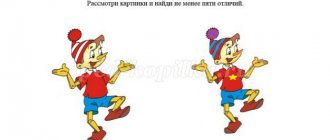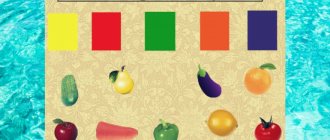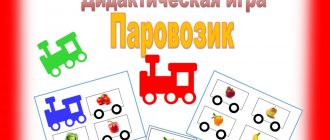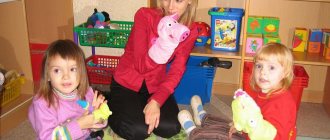What games help develop sensitivity at all levels?
Since I’m in the younger group, I’ll give you my card index, but I’ll try to make additions for different ages. In general, the meaning of such games is this: to give the child a wide range of sensations and knowledge about the properties of objects, substances, phenomena that can be felt tactilely, visually, auditorily and “smelling”. In the same way, these same sensory-didactic, that is, educational games are suitable for young children. It is necessary to select games that are adequate to the child’s age capabilities.
For simplicity, I divided the card index into 5 blocks: the development of visual perception, auditory, olfactory, tactile, as well as games for fine motor skills and purposeful actions.
I will not describe absolutely all the components of the card index, and it would be stupid to list them without a description, because you can’t always understand the essence by the name, so I will give a description of the most effective games for sensory development. You will see how simple, interesting and useful it is to amuse your baby and teach at the same time!
So, 1 block of didactic games for training visual sensitivity:
- “Lids and boxes”: you can take empty plastic jars with gouache lids, they are usually multi-colored. Place cards inside to match the color of the box. For older children, you can place beads or other small objects in monochrome colors.
Objectives: we train the ability to correlate colors, find identical ones, analyze and systematize. At the same time, we train motor skills, learning to open lids. We exercise the ability to distinguish shape and size. If you shake a jar with a card inside, you will also train your hearing.
Believe me, if you complicate the task, the middle and older groups will be interested in this game. For them, you can add shades of colors, place inside a card with a picture that is not monochrome, but made predominantly of one color. We select lids with threads to make it more difficult to open.
- “Vegetable Garden” is a game for the development of sensory standards. We take small square cardboards, draw the outline of a fruit or vegetable on them and cut out the middle. Separately, we have cardboard boxes of the same size, but completely painted over, matched to the colors of the prepared fruits and vegetables. Task: find its color for each fruit and place the blank on top of the corresponding colored cardboard.
Didactic games for the development of auditory perception: 2nd block
- To organize this type of game, waste material is suitable. For example: “Colorful noisemakers.” We take plastic bottles and glue labels of different colors to them, but of the same color. We will stir anything inside, as long as it fits into the neck and is matched to the color of the label: dyed legumes, cereals, beads, sand. The baby shakes these noisemakers, now stronger, now weaker, catching the difference in the sounds made.
At the same time, we will train our visual perception of color and motor skills. Children aged 2-3 years love this game. In the second junior group, and even in the first junior group, this fun is a great success. Apparently, babies still miss rattles...
And to make the fun more interesting in the 1st junior group, you can decorate the noisemakers in the form of toys: take a plastic Kinder egg, put different objects inside (cereals, a ball, whatever), cover them with fabric or crochet them, creating chickens, for example. Each chick will make different noises.
The preparatory group can complicate the task: pour the contents of the bottles into separate boxes and then again select the filling required for each specific bottle by color. In addition, if you shake bottles consciously, you develop a sense of rhythm, and this is an ear for music!
- "Who's making noise?" – goes well in the middle group. Behind the child’s back, we make characteristic sounds using any objects: rustling the pages of a book, knocking something on the table, etc. The child must guess what makes the sounds. Great ear training!
Block 3: developing the sense of smell...
There is no need to go far here; the games smoothly move into the kitchen. The average group can cope with this task quite well:
- “Guess what the chick will eat?” – the child plays the role of a hungry chick, and someone else imagines himself as a mother bird who has flown in to feed her young. But the mother is cunning: the chick must first guess by the smell what the mother brought him. We bring the child a piece of something edible and let him inhale the aroma. This is very interesting for older children, but the 2nd younger group can also try to guess.
- Older preschoolers will enjoy competing in the game “What does it smell like?” The idea is this: we make small bags of gauze in advance, and immediately before the game we place pieces of food with a characteristic aroma into the bags: citrus fruits, coffee beans, onions, garlic, apples, etc. Again, the baby guesses what’s inside.
Now the expanse of fruits, the preparatory group and younger preschoolers can train a more subtle sense of smell, let them learn to distinguish the smells of vegetables and fruits with a weakly expressed aroma.
Despite the simplicity of such didactic games, they are of great benefit. Through play, the child receives full sensory education and enriches the world of his sensations. And this already develops the brain as a whole. Moreover, our vocabulary is also enriched, because we learn new words.
4th block: enriching tactile sensations
- “Surprise”: place a deep container with sand, cereals, etc., in which objects are hidden. The child finds it, rejoices and at the same time develops the sensitivity of his fingers.
- “Hello!”: we make blanks in advance from materials of different textures, gluing them onto cardboard and cutting out palms. The child puts his palm on the workpiece, feels the texture, learns new concepts: smooth, rough, soft, fluffy.
- “Sinking or not sinking”: we take a container with water and in another container - different objects that can be soaked in water. The child explores which objects sink and which do not, and tries to guess in advance the possibility of floating on the water.
To develop tactile sensations, you can use everything you see around the house while walking. Yes, the child trains himself, feeling everything that comes to hand. But it is imperative to focus the baby’s attention on the names of phenomena and sensations. Pay attention to color, shape, size.
What can I say, you have already guessed how useful didactic games for the development of tactile sensations are for little autistic children - autistics, and for all children with mental retardation (mental retardation).
Block No. 5: learning to take purposeful actions
- “We sell cereals”: we pour different types of cereals or sand into bowls, we learn to pour cereals into other containers, as if for a buyer.
- “Treat the doll with candy”: take round plastic round containers with lids and decorate them in the shape of a doll’s head. Glue or draw a face and hair. We cut a small hole in place of the mouth. Separately, we are preparing a box with multi-colored buttons, which will be our candies. You need to push the candy button into the doll’s mouth.
- Exercise machines with laces, Velcro buttons, clasps, etc. work great for educational purposes. At least you need to make a simulator with buttons: sew buttons onto the fabric, stretch the fabric onto plywood or something similar. Separately, we make blanks with loops for buttons, for example, these are flower petals that need to be attached to a button and made into a flower.
Even the descriptions of several games took up a lot of space on the blog page. I suggest just buying special literature and making your own card index of didactic games.
So, manuals from UchMag:
- “Sensory development of young children. 1-3 years." While the book is out of stock, you can always leave a request for a missing item on this website;
- “Sensory development of children 2-3 years old. Color. Form. Size” – here are presented didactic games and exercises for organizing joint activities between the teacher and young children;
- “Sensory development of children 3-4 years old. Color. Form. Size" - the same for younger preschool age;
- “Sensory development of children 4-5 years old. Color. Form. Size” – respectively, average preschool age;
- “Sensory development of children 5-6 years old. Color. Form. Size” – materials for the older group;
- “Sensory development of children 6-7 years old. Color. Form. Size" - for the preparatory group.
Do-it-yourself didactic games for sensory development
Kozlova Tatyana
Do-it-yourself didactic games for sensory development
Didactic games for sensory development of young children.
My teaching activity is related to young children. My children's ages are from 1.5 to 3 years. This age is most favorable for the sensory development of children. Mastering knowledge and skills requires constant attention to the external properties of objects (shape, color, size). I believe that this topic is most relevant in our time. The leading type of activity and the basis for the development of a child up to three years of age is object-based play. The purpose of these games is to help consolidate the qualities of objects (size, shape, color). With young children I conduct games - activities in which the presentation of any material occurs unnoticed by the children, in practical activities. I would like to share with you didactic games for the sensory development of preschool children, which I made with my own hands.
D/game “Find the same leaf by color”
D/game “Collect the picture” (geometric mosaic)
D/game “Find a pair”
D/game “Find a pair” (fruits and vegetables)
D/game “Colorful palms”
D/game “Collect the caterpillar”
D/game “Find a dress of the same color”
D/game “Find the same figure” (color, shape)
D/game “Pick up the sun’s rays”
D/game “Assemble a pyramid” (color, size)
D/game “Find a pair” (color)”
D/game “Find a ball of the same color”, “Match the thread to the ball”
D/game “Match the saucer to the mug” (color)”
D/game “Decorate the figure” (color, shape and size)”
Didactic games with your own hands Games with traffic jams have a beneficial effect on the development of fine motor skills. Screwing and unscrewing them develops the hand and wrist. For awakening.
Do-it-yourself didactic games for the sensory development of preschoolers My topic on self-education “The role of didactic games in the sensory development of preschoolers” I would like to bring to your attention several didactic ones.
Do-it-yourself didactic games 1. Game “Domestic and wild animals.” 2 pictures are pasted onto the cardboard: a forest and a village, holes are made and screw necks are inserted.
DIY didactic games Dear colleagues! I bring to your attention didactic games for the 2nd junior group, made with my own hands. All games are quite simple.
Didactic games with your own hands In childhood, a child has a need to play. And it must be satisfied not because business has time, fun has an hour, but because...
Didactic games with your own hands Starting from a very early age, the child actively explores the world, exploring everything that happens around him. Therefore, didactic games are of the utmost importance.
Didactic games with your own hands for children 2-3 years old Didactic games with your own hands for children 2-3 years old Collect a bouquet in a vase Goal: development of sensory abilities in young children..
Do-it-yourself didactic games on sensory education for young children Game “Hide the Bunny” There are many varieties of the game “Hide the Bunny”. It is made from colored paper, wood, and sewn from material.
Do-it-yourself didactic games Performed by: S. I. Kochneva Didactic game: “Arrange by color” Purpose: To consolidate the primary colors; Development of fine motor skills of the fingers. Didactic.
Do-it-yourself musical and didactic games Do-it-yourself musical and didactic games How many useful things can be made from containers from Kinder surprises! A variety of crafts and supplies.
Sensory education of children through didactic games
Sensory is the ability to sense external influences and stimuli. This concept includes a wide variety of sensations. The importance of sensory perception is confirmed by the fact that it is placed on the same level as mental development.
Didactic games for preschoolers are a type of thematic activities that are built in accordance with the principles of pedagogy and are a means of self-education. Sometimes preparatory steps are required to introduce a lesson or obtain a theoretical basis.
The role of didactic games in the sensory development of young children
If you integrate didactic classes, they will help to form an understanding of the external properties of objects and phenomena. For example, characteristics include shape, color, size, position in space, change over time, tactile properties, smell, taste, and more. In addition to the development of all forms of perception, didactic exercises are aimed at actively training fine motor skills of the hands.
Sensory development of young children through didactic games is a priority direction in activities in preschool classes, since it not only shows high results, but is also liked by children.
Important! Developing sensory skills is not just the job of certified teachers. Parents should provide all possible assistance for the educational process. Sensory development of children 2-3 years old through didactic games is also available at home, so classes can be continued outside the preschool. It is recommended to first attend a consultation or an open lesson with a teacher in order to do everything correctly.
Card index of didactic games for sensory development of children 2-3 years old
A sensory lesson in the 1st junior group according to the Federal State Educational Standard is held to teach children basic colors, shapes and sizes.
"Button House"
Goal: training the skill of recognizing and distinguishing colors.
Materials: a circle divided into 4 multi-colored sectors, with four buttons to match each sector.
Progress: the teacher explains that each button must find its own home, which matches its color. The child selects a button and places it in the desired sector. The color is called out loud.
"Color Field"
Goal: training the skill of recognizing and distinguishing colors.
Material: circle with colored sectors (number of colors to choose from), which has an analogue of a hand, like in a watch. Children are given a set of cards where the colors match the sectors in the circle.
Progress: the teacher rotates the arrow and shows the color. Children choose the one they want from their cards and show it.
"Air balloons"
Goal: training the skill of recognizing and distinguishing colors.
Materials: several balloons of different colors and ribbons to match them.
Progress: the child is asked to match each ball with a ribbon of the same color.
“What kind of figure is this?”
Goal: to teach the child to find figures in things and objects around.
Materials: cardboard square, triangle and circle.
Progress: the teacher shows the figures one by one and asks the child to walk around the room and find objects that would be similar to them. These could be wheels, an aquarium, plates, a cabinet. You can complicate the task by specifying the color of the objects to look for.
"Hide from the Rain"
Materials: 4 cardboard squares, circles and triangles, as well as three cut out umbrellas.
Progress: the teacher lays out a template, under each umbrella there is one figure. The following describes the game situation: it has started to rain, but the pieces can only hide under their umbrella. The child moves the cards to the correct place.
Important! The teacher is an active participant in each game. Unlike other activities, here he cannot be observed from the outside. The teacher conducts a sensory lesson in the first junior group, directs it in the direction that would better accomplish the task.
Umbrella games have several variations
Didactic games on sensory education for preschoolers
Sensory perception is aimed at developing sensations and creating a system of reactions to them. Considering that the formation of sensory culture occurs at a deep level of the subconscious, it is necessary to find subtle teaching methods. Simply telling the theory and showing how to behave is an ineffective plan. Sensory education should take place in the process of different types of activities. Didactic games for sensory development turned out to be especially successful.




